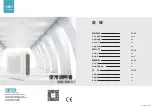
5.10.2 Flaring work
Carry out flaring work using a flaring tool and compare the flared work with
the provided figure. If the flare is noted to be defective, cut off the flared
section and do flaring work again.
Good example:
a Smooth all around
b Inside is shining without any scratches
c Even length all around
Bad examples:
d Too much
e Titled
f Scratch on flared plane
g Cracked
h Uneven
5.10.3 Connecting the refrigerant connections to the indoor unit
Caution
Use a counter-key to prevent the refrigeration link from twisting.
1. Cut the refrigerant pipes coming from the outdoor unit with a pipe
cutter and deburr.
2. Unscrew the protective cap from the liquid line of the refrigerant
connector and discard.
3. Check the exchanger leak-tightness. Push a screwdriver gently into
the 1/4" nut. A release noise should be heard, which is proof that the
exchanger is leak-tight.
4. Remove the liquid line nut and throw it away.
5. Remove the gas nut and throw it away.
6. Add a pipe adapter if necessary
7. Engage the nuts from the accessory bag onto the refrigerant pipes.
8. Flare the refrigerant connections.
9. Apply refrigerant oil to the flared parts to facilitate tightening and
improve the seal.
10. Tighten the connections, observing the given tightening torques.
Tab.102
External diameter of
the pipe (mm/inch)
External diameter of
the cone fitting (mm)
Torque load (N.m)
6.35 - 1/4
17
14 - 18
9.52 - 3/8
22
34 - 42
12.7 - 1/2
26
49 - 61
15.88 - 5/8
29
69 - 82
19.05 - 3/4
36
100 - 120
5.10.4 Connecting the refrigerant connections to the outdoor unit
Caution
Use a counter-key to prevent the refrigeration link from twisting.
1. Remove the protective side panel from the outdoor unit.
2. Check that the stop valves are closed.
3. Remove the protective caps from the valves and throw them away.
Fig.195
a
e
c
c
b
d
f
g
h
MW
-1
0
0
1
7
4
5
-2
Fig.196
MW-1002117-1
Fig.197 Pipe adapter
MW-6070061-01
Fig.198
MW-1001648-1
5 Installation
en
7798731 - v01 - 18112021
167














































